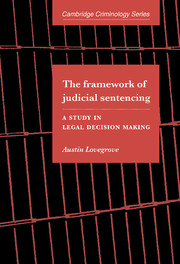Book contents
- Frontmatter
- Contents
- List of figures
- List of tables
- Acknowledgments
- 1 Judicial decision making and sentencing policy: continuation of a study
- 2 A sentencing decision model: single and multiple similar counts
- 3 A sentencing decision model: multiple disparate counts
- 4 Testing the decision model for multiple disparate counts
- 5 The techniques of data collection
- 6 Judges' thoughts on sentencing the multiple offender
- 7 An alternative sentencing decision model for the multiple offender
- 8 Validity and development of the alternative decision model: the data collection
- 9 Towards a requisite decision model for sentencing the multiple offender
- 10 The armature of judicial sentencing
- Appendix 1 Case 37 from Sentencing Research Exercise – Part 3B
- References
- Index
8 - Validity and development of the alternative decision model: the data collection
Published online by Cambridge University Press: 22 August 2009
- Frontmatter
- Contents
- List of figures
- List of tables
- Acknowledgments
- 1 Judicial decision making and sentencing policy: continuation of a study
- 2 A sentencing decision model: single and multiple similar counts
- 3 A sentencing decision model: multiple disparate counts
- 4 Testing the decision model for multiple disparate counts
- 5 The techniques of data collection
- 6 Judges' thoughts on sentencing the multiple offender
- 7 An alternative sentencing decision model for the multiple offender
- 8 Validity and development of the alternative decision model: the data collection
- 9 Towards a requisite decision model for sentencing the multiple offender
- 10 The armature of judicial sentencing
- Appendix 1 Case 37 from Sentencing Research Exercise – Part 3B
- References
- Index
Summary
This study has now reached a point where there is an alternative model describing the principles and working rules relied on with varying awareness and comprehension by judges in order to determine, according to current sentencing policy, effective sentences for multiple offenders where the counts are separate transactions and offence categories and once an appropriate sentence of imprisonment has been fixed for each of the multiple counts. This model was formulated in the previous chapter on the basis of the judges' responses to the sentencing problems. In the sentencing of the multiple offender, principle dictates that more serious principal offences require a higher effective sentence and more serious and additional multiple secondary counts require a greater quantum of sentence to be added to the sentence for the principal offence. Nevertheless, this cumulation must not result in what would be a crushing sentence on the offender. The model, then, is also concerned with the principle governing the constraint on the cumulation of sentence, and this was discerned to be: the higher the sentence appropriate to the principal offence and the higher the sum of the sentences appropriate to each of the other (i.e., the multiple secondary) counts, then the greater the degree of concurrence for each of the appropriate sentences associated with the multiple secondary counts.
In view of the alternative model's provenance, a rigorous test of its validity requires the formulation of new sentencing problems specifically designed to test predictions from it, especially for those aspects inconsistent with its forerunner.
- Type
- Chapter
- Information
- The Framework of Judicial SentencingA Study in Legal Decision Making, pp. 169 - 203Publisher: Cambridge University PressPrint publication year: 1997



